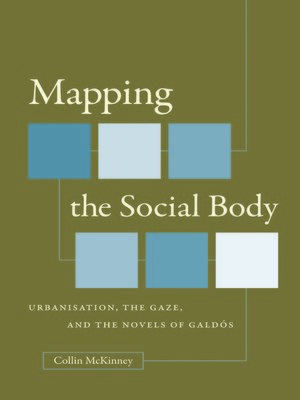Mapping the Social Body
ebook ∣ Urbanisation, the Gaze, and the Novels of Galdós · North Carolina Studies in the Romance Languages and Literatures
By Collin McKinney

Sign up to save your library
With an OverDrive account, you can save your favorite libraries for at-a-glance information about availability. Find out more about OverDrive accounts.
Find this title in Libby, the library reading app by OverDrive.



Search for a digital library with this title
Title found at these libraries:
| Library Name | Distance |
|---|---|
| Loading... |
Influenced by trends in medicine, town planning and social etiquette, Madrid's middle class viewed urban growth with apprehension in the second half of the nineteenth century. In Mapping the Social Body, Collin McKinney examines manifestations and critiques of that reaction in the work of Benito Pérez Galdós, Spain's greatest modern novelist. Drawing on a wide range of recent cultural theory as well as contemporary non-literary texts, this book provides modern readers with a metatextual map of Galdós's Madrid and Spanish society as they experienced urbanisation.
In a century obsessed with all things visual, the map became a useful model with which the recently formed middle class hoped to reform a social body ravaged by disease, crime, prostitution, and class conflict. This study finds that Galdós's attitude toward the middle class and its mapping enterprise changes over time. Whereas his early novels depict dividing practices as reliable and perhaps necessary, his later works show Spain's social maps to be subjective and discriminatory. In La desheredada, Tormento, and La de Bringas the social body is mapped according to class, genealogy, gender and physical difference. Physically and morally ambiguous, the characters in Fortunata y Jacinta, Nazarín, and Misericordia are unmappable and thus resistant to the bourgeois categorising gaze.
In a century obsessed with all things visual, the map became a useful model with which the recently formed middle class hoped to reform a social body ravaged by disease, crime, prostitution, and class conflict. This study finds that Galdós's attitude toward the middle class and its mapping enterprise changes over time. Whereas his early novels depict dividing practices as reliable and perhaps necessary, his later works show Spain's social maps to be subjective and discriminatory. In La desheredada, Tormento, and La de Bringas the social body is mapped according to class, genealogy, gender and physical difference. Physically and morally ambiguous, the characters in Fortunata y Jacinta, Nazarín, and Misericordia are unmappable and thus resistant to the bourgeois categorising gaze.







